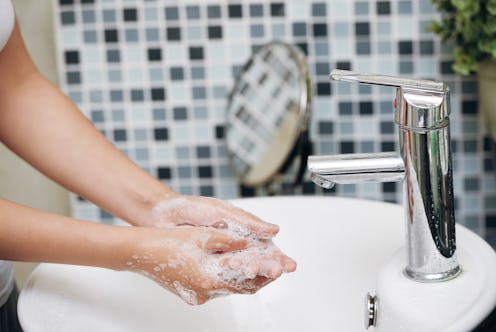Life
These 3 Kinds Of Deadly Bacteria Are Probably In Your Bathroom Right Now

Horror stories about bacteria in your/everyone's bathroom are everywhere. A study in 2018 found that hand driers in public rest rooms tend to blow poop bacteria around the room, which caused a small panic among everybody who’s ever used a department store toilet. And your everyday bathroom can harbor some deadly bacteria, even if it’s very well-maintained. As the place where we wash ourselves and dispose of our waste, it's the place where germs are bound to end up.
Bacteria in the bathroom can transfer from surfaces to the human body through something called, charmingly, the fecal-oral route. It's the main way in which fecal material and its accompanying nasties can make its way into the human body. But unless you're going around licking unwashed surfaces in the bathroom, you probably aren't likely to develop infections from any of these bacteria, especially if you practice good hygiene and wash your hands after using the restroom. What's more, simply cleaning your home bathroom regularly (and, again, washing your hands after doing so) can help mitigate the possibility of getting sick from these kinds of bacteria. Here are three especially nasty strains of bacteria that are more-than-likely lurking in your bathroom.
1Staphylococcus aureus
This bacteria can cause staph infections that are the bane of hospitals and other areas where sick people tend to be in close proximity. Staph is one of the biggest causes of skin diseases in humans, causing everything from boils to internal infections. The superbug MRSA is a variety of staph; its name stands for “methicillin-resistant staphylococcus aureus,” which means normal antibiotic remedies don’t work.
However, it’s important to note that staph aureus bacteria are part of perfectly normal skin bacteria and tend to live harmlessly inside the nose and on the skin in about a quarter of the population; they make up about 5 percent of the natural bacteria living on your body, so they’re not villains all the time. Again: if you're concerned about it, wash your hands frequently.
2E. Coli
E.coli is another example of a bacterium that lives harmlessly in the body, but can cause stomach pain, nausea, and diarrhea when it gets out of hand. It’s a part of functioning gut flora, the micro biome of bacteria and other organisms that helps your gastrointestinal system work well. When E.coli lives surfaces in the bathroom, though, it can prove to be much more of a health risk.
There are multiple kinds of E.coli; some are harmless and others are pathogenic, causing illness in humans. E.coli are particularly prone to flourishing near and on toilet seats, unhelpfully enough, according to hygiene engineer Dr. Mai Ha in GQ. If you're worried about this bacteria, wash your hands and clean your living space frequently.
3Shigella
Shigella germs cause shigellosis, which is spread by — you guessed it — poop. You can contract it by eating food prepared by somebody who's got the bacteria on their hands or transferring the bacteria to your mouth from a surface, like a bathroom door handle. It's an intestinal infection and can clear up on its own, though severe cases still need antibiotics. It can also develop into dysentery, and is regarded as a life-threatening condition in the developing world, according to the World Health Organization.
4
Fortunately, if the idea of these bacteria lurking in your bathroom gives you the creeps, the solution is simple: just clean up. Always wash your hands after using the toilet or spending time in the bathroom (and especially before touching your face), use bleach solutions and hydrogen peroxide while cleaning, wash towels and mats — which can also harbor germs — thoroughly, and wipe down surfaces like toilet flush handles regularly.